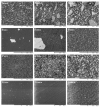Influence of Curing Time on the Microbiological Behavior of Bulk-Fill Nanohybrid Resin Composites
- PMID: 34502989
- PMCID: PMC8434565
- DOI: 10.3390/polym13172948
Influence of Curing Time on the Microbiological Behavior of Bulk-Fill Nanohybrid Resin Composites
Abstract
This in vitro study aimed to evaluate the influence of curing time on surface characteristics and microbiological behavior of three bulk-fill resin-based composites (RBCs). Materials were light-cured for either 10 s or 80 s, then finished using a standard clinical procedure. They were characterized by surface morphology (SEM), surface elemental composition (EDS), surface roughness (SR), and surface free energy (SFE). Microbiological behavior was assessed as S. mutans adherence (2 h) and biofilm formation (24 h) using a continuous-flow bioreactor. Statistical analysis included a two-way ANOVA and Tukey's test (p < 0.05). Materials differed substantially as filler shape, dimension, elemental composition and resin matrix composition. Significant differences between materials were found for SR, SFE, and microbiological behavior. Such differences were less pronounced or disappeared after prolonged photocuring. The latter yielded significantly lower adherence and biofilm formation on all tested materials, similar to conventional RBCs. Improved photoinitiators and UDMA-based resin matrix composition may explain these results. No correlation between surface characteristics and microbiological behavior can explain the similar microbiological behavior of bulk-fill materials after prolonged photocuring. This different performance of bulk-fill materials compared with conventional RBCs, where surface characteristics, especially surface chemistry, influence microbiological behavior, may have important implications for secondary caries occurrence and restoration longevity.
Keywords: Streptococcus mutans; bacterial biofilm; bioreactor; bulk fill; composite resin; energy-dispersive X-ray spectroscopy; microbial adherence; restorative materials; scanning electron microscopy; surface characterization.
Conflict of interest statement
The authors declare no conflict of interest.
Figures




References
-
- El-Banna A., Sherief D., Fawzy A.S. Advanced Dental Biomaterials. Woodhead Publishing; Cambridge, UK: 2019. Resin-based dental composites for tooth filling; pp. 127–173. - DOI
LinkOut - more resources
Full Text Sources
Molecular Biology Databases
Research Materials
Miscellaneous

